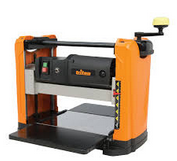Slightly vague question for which I apologise but I'm basically thinking out loud here.
I am happy with the results from my planer thicknesser, one of these

the wood comes out pretty much smooth as glass. Roughly speaking what sort of level of grit in sandpaper is it equivalent to? I've no experience with the higher number sandpaper grits.
I am happy with the results from my planer thicknesser, one of these

the wood comes out pretty much smooth as glass. Roughly speaking what sort of level of grit in sandpaper is it equivalent to? I've no experience with the higher number sandpaper grits.

































